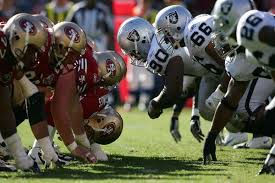The Oakland Raiders: the Candlestick Days
- David Hegler

- Oct 5, 2023
- 3 min read

In their early years, the burgeoning city of Oakland didn't have a stadium for their professional football team. So the Raiders traveled across the Bay Bridge where they found sites for their home games at Kezar Stadium and the recently opened Candlestick Park.
1960
For an expansion team, the Raiders were not bad, sporting a respectable 5-6 record by the time they moved into Candlestick Park for the final three games of their inaugural season. They felt like kings with 15,000 watching their first game at the converted baseball park. It didn't matter that they lost badly to the Chargers. All that mattered to them on that cool early December afternoon was the fact that they drew one of the largest crowds of the season. Perhaps they could draw larger crowds in the near future?
However, sentiment for the team from the City Across the Bay didn't last long within the City by the Bay. The Raiders saw the numbers at the box office dwindle rapidly during the last two games of the season. Just over 9,000 watched them lose a close 31-28 contest to the New York Titans a week after their Candlestick debut. A week after that, they blew out the Broncos 48-10 in front of 5,129 fans, a paltry sum even for an expansion team. The Raiders brass knew that they needed to do something in a hurry before the team faced bankruptcy.
1961

Surely their second year of existence would be easier, right? Wrong! As the Raiders got used to their surroundings at Candlestick Park, they would suffer one of the worst seasons in franchise history. After beginning the year 0-2 and firing their first coach Eddie Erdelatz, they promoted line coach Marty Feldman to take his place. Things only got worse from there.
Against the Texans in their third game of the year, the Raiders dropped a 42-35 shootout in front of just 6,700 attendees. While Tom Flores did his part with 182 yards passing and two touchdowns, his defense was a sieve, giving up 247 yards to future Raider Cotton Davidson and four touchdowns in the second half.
The Raiders put together a winning effort the following week against the Broncos, winning 33-19. But their second-half defensive struggles continued, despite holding a 26-3 halftime lead.
Three weeks later, they would fall victim to Sid Gillman's brilliant offensive mind and the San Diego Chargers, losing 41-10. Even though he would later be considered a quarterback aficionado, Sid Gillman tended to have very productive rushing attacks in those early years. Paul Lowe dominated the Raiders from start to finish, rushing 11 times for 106 yards and two touchdowns.
The following week, the Raiders lost a nailbiter to the Titans, 14-6. While the Raiders kicked two field goals, the Titan's Bill Mathis plowed his way to his team's only points, rushing 16 times for 76 yards and two touchdowns.
Four weeks later, the Raiders returned home with a 2-10 record hardly to boast of. Determined to not end the season with just two losses, the Raiders took an early 7-6 lead off of a 15-yard scoring connection between Nick Papac to Alan Miller. But of course, their porous defense couldn't protect the lead for long, watching the Bills take the 26-21 decision.
Inspired by that brief moment of spirit earlier in the game, the Raiders fought harder and longer against the Patriots the following week, matching their opponents blow for blow... in the opening period. the second quarter was a different story as Boston pulled away 14-0, ultimately the deciding points in the 35-21 loss.
Eight days later, the Raiders season mercifully came to an end in front of a sparse crowd of 4,821. It was probably for the best that the stands were so empty as there were fewer witnesses to the Raiders' embarrassing 47-16 loss to the Oilers. Once again, the Raiders took an early lead (field goal) and once again they let it slip away. That day, they took a good look at their future as both George Blanda (18-31, 350 yds, 4 tds) and Billy Cannon (21 carries, 145 yards, 1 td) both had big games against the Raiders. Years later, each would play a role in helping the Raiders reach Super Bowl II.
With Frank Youell Field having been completed in time for the new season, the Raiders moved to the city that they represented the following year. Candlestick Park would remain a baseball-only facility for the rest of the decade until the 49ers moved into the recently enclosed ballpark in 1970.



Comments